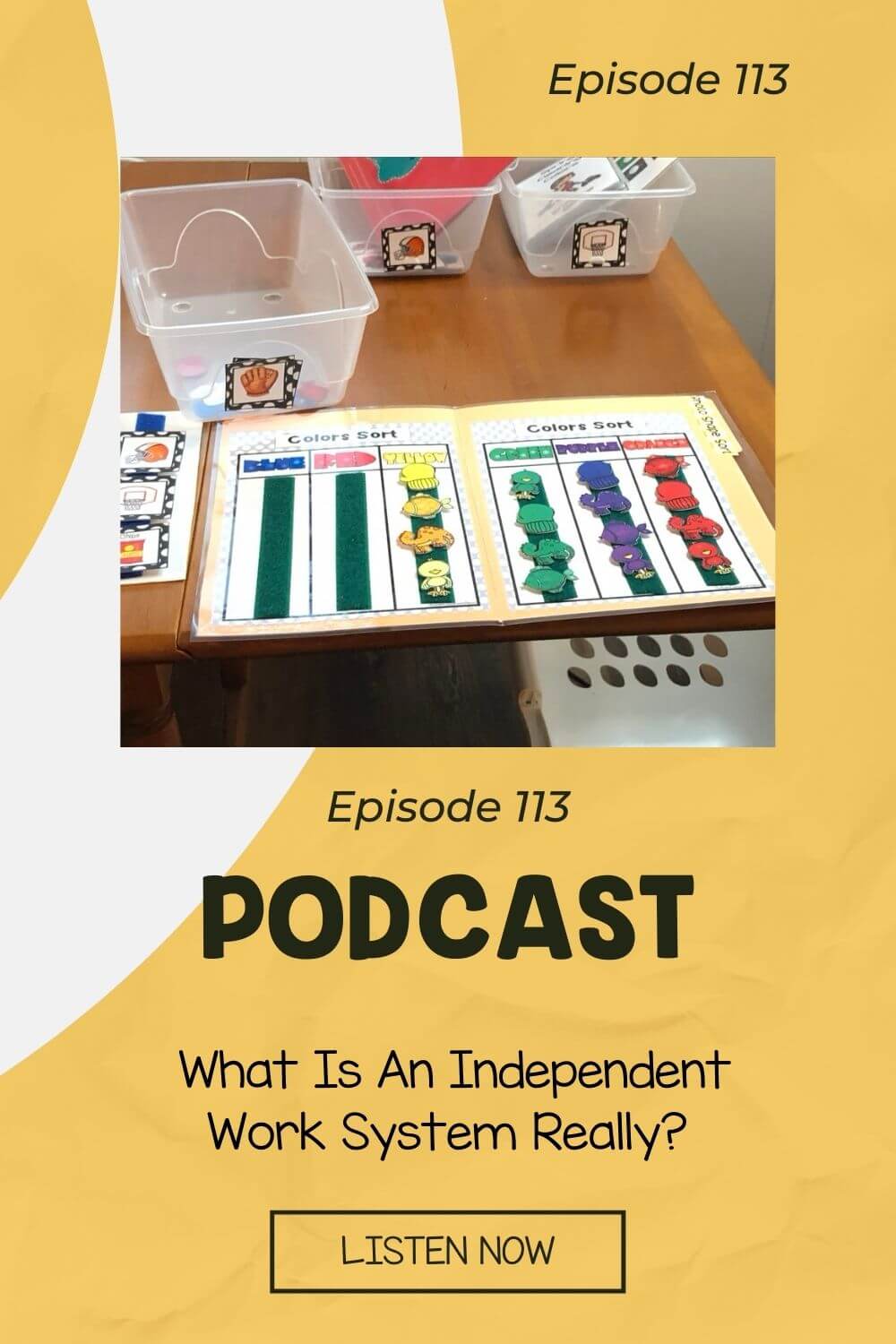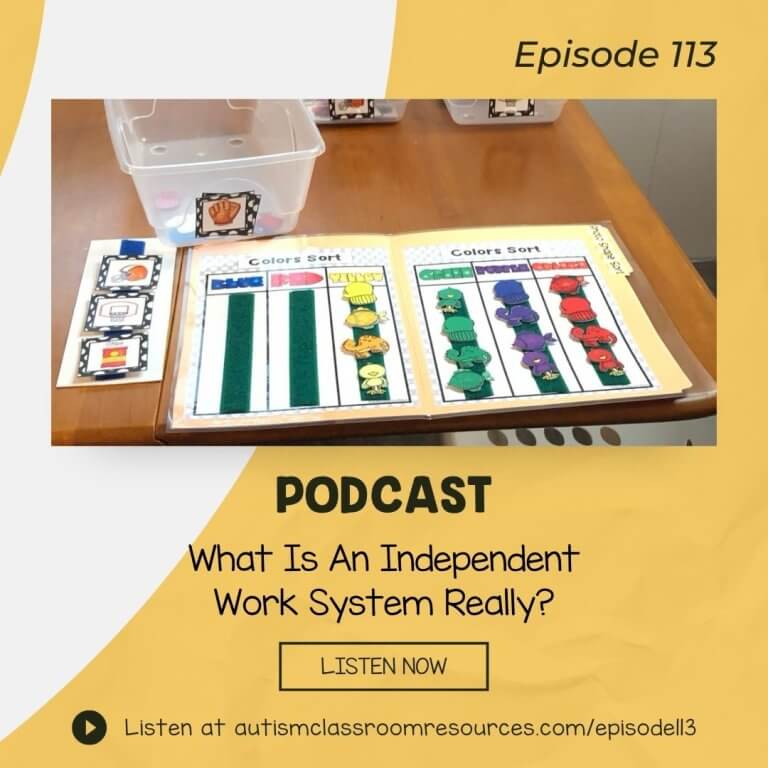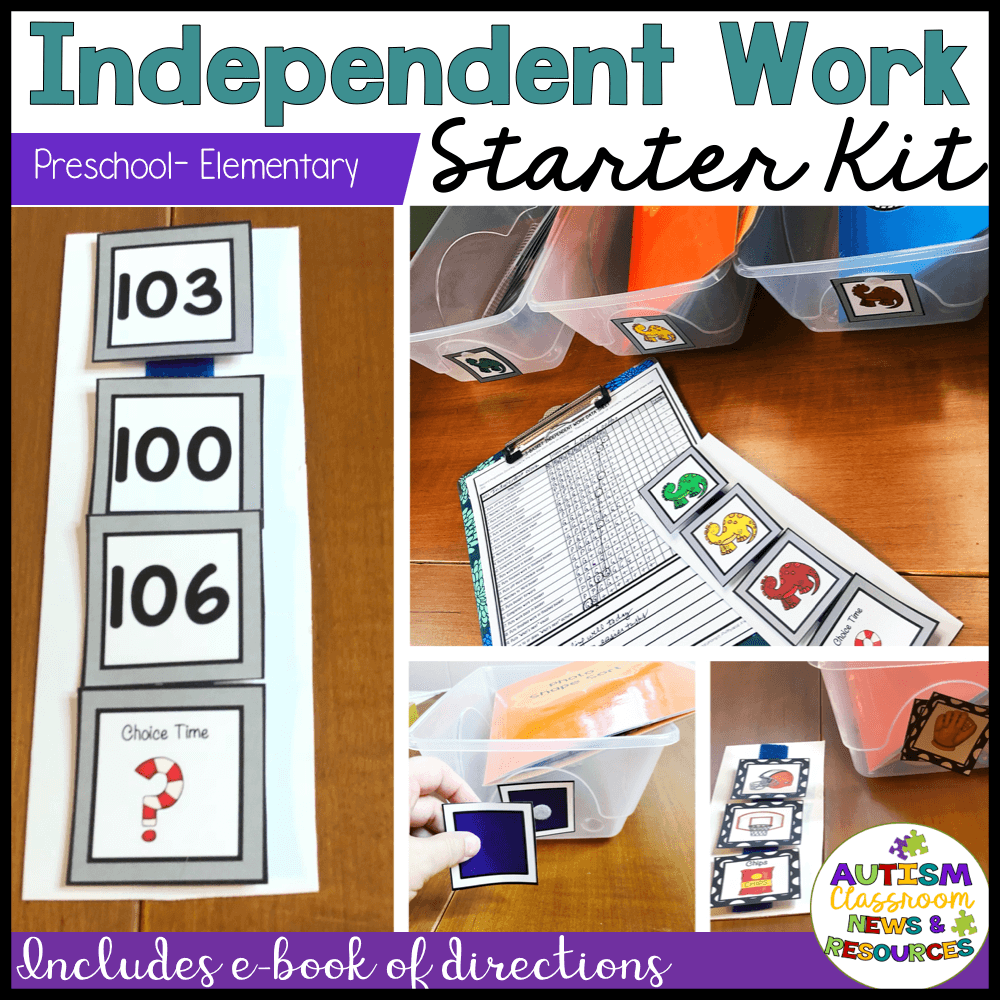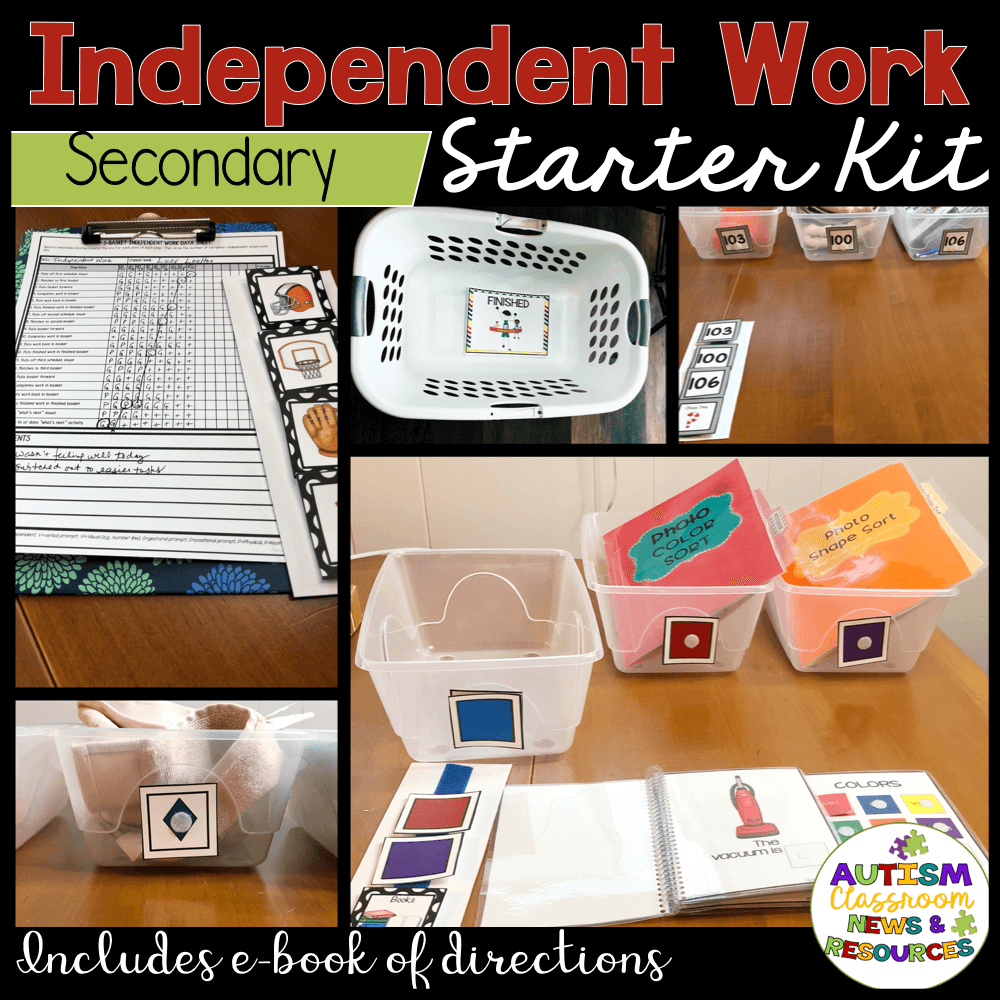Welcome to the Autism Classroom Resources Podcast, the podcast for special educators who are looking for personal and professional development.
Christine Reeve: I’m your host, Dr. Christine Reeve. For more than 20 years, I’ve worn lots of hats in special education but my real love is helping special educators like you. This podcast will give you tips and ways to implement research-based practices in a practical way in your classroom to make your job easier and more effective.
Welcome back to the Autism Classroom Resources Podcast. I’m Christine Reeve. I’m your host. I am kicking off a new month talking all about independent work systems. If you follow me on social, you’ve probably seen my Workbasket Wednesday posts and my regular posts about independent work. I love independent work systems, and I’ll tell you some of the personal reasons why in next week’s episode. But today I want to tell you exactly what independent work systems are because believe it or not, there is a lot of misinformation out there about what they actually are.
It’s funny because I started working in this field a long, long time ago before the internet, before social media. Those of you who have been around as long as I have will remember that we didn’t have the ability to print off our visuals in color or even print pictures. We didn’t have Pinterest and we didn’t have Instagram. Boy, this is starting to sound like the good-old days were crazy, but it meant that we didn’t have the ability to just go to our computers and look up ideas for independent work systems. When digital cameras first came out, I bought one and I started filling up three and a half inch floppy disks—and if you don’t know what that is, just go Google it—with pictures of every task that I saw in classrooms so that I could put them together in presentations instead of carrying the actual tasks with me on the road and put them in books.
Because up until then, the only way that we had to really share independent work tasks was to show the actual tasks or to have gone to a training at division TEACCH, and gotten what they gave as part of that training, which is a black and white book with photos of tasks; or to know somebody who went to that training and would be nice enough to let you borrow it. Borrowing it wasn’t as easy as it sounds because they were extremely precious and many of those people were reluctant to let it go.
Why am I going on and on about the good-old days or the not-so-good old days? Well, because there are some really good things about social media and there are some not so great things about social media as I know that we all know. I am not talking about politics at all, I promise. The good thing is that we have tons of examples of tasks now and we can go and share them and get them, and you can go on Pinterest and put in tasks and find a million of them now, which was amazing when that started. The bad thing is that there is a ton as well of misinformation and bad examples of tasks and systems out there, of things that aren’t really independent work systems, that aren’t really what I would say the things that are called task boxes, that aren’t necessarily what need to go into independent work systems.
If you don’t know what independent work systems are really designed to be and why the elements are supposed to be there in the first place, then you don’t know whether the “modifications” are okay for your students and what you’re trying to do. That’s what I want to talk about today is what independent work systems really are designed to be so that we all start talking about them this month on the same page. Because frankly, it really drives me crazy to see some of the stuff that’s out there, so I’ll try to keep my frustration to a minimum. I just want to make sure that you know what you’re looking at. Making changes to the system isn’t a bad thing as long as you know why you’re doing it and what you might be sacrificing or gaining by making those changes.
Now before we get started, do you know what I did with all those pictures that I put on those floppy disks? I co-wrote a book, a number of years much later than I intended, about independent work systems. It’s got tons of ideas and information about the system set up the right way and why we do the things we do. I’ve even got a shortcut for you so if you’re not a reader, you don’t want the book, if you think that you’re ready to really get started with independent work systems right in your classroom, I’ve got a free webinar that can get you started quickly the right way in your classroom. It’s got a bonus, if you watch it to the end, of materials to help you get it set up and help you monitor your students’ independence as well. You’ll find the link to that in the show notes as well as lots of other things or at autismclassroomresources.com/episode113. Now let’s get started.
Our question today is what is an independent work system? Independent work systems or structured work systems, as they’re formally called, began with division TEACCH at UNC North Carolina at Chapel Hill. If you’ve heard all this before, just stick with me for a minute or so. Essentially, they’re a way to structure a series of tasks so that the sequence of the tasks is clear and the student can complete them independently. They can be arranged in a lot of different forms—they might have basket notebooks, lists—but every single independent work system has to answer four questions: (1) What work must be done? (2) How much work must be done? (3) How do I know when I am finished? (4) What do I do next? These questions are designed to be answered through the visual structure of the system itself.
Now most of you are probably familiar with the basket type of independent work system. That’s the one that I think is probably most common that people have seen. Many people have seen it online. We often talk about them as basket systems. Unfortunately, they become so common that a lot of times, that’s the one that loses its structure the most in terms of really answering those questions. Sometimes, I meet teachers who think that it’s the baskets or the task boxes that make the system independent work, but in reality, it’s whether or not the system is set up and the tasks in the setup that answer those questions, it’s whether or not it’s set up in a specific way.
Independent work systems were designed by TEACCH based on the observation that many or most individuals with ASD have very strong visual skills that are stronger than our auditory skills, which is something many of us know about individuals with autism. The systems are set up to capitalize on those strengths. The systems always are set up working from left-to-right and top-to-bottom because, well, reading, and we want to make sure that there are clear cues for the students about where a task begins and ends. There’s an increasing evidence base for independent work systems. They’ve been in and out of the evidence-based category for the past 15 years in the big organizational reviews that are done.
Currently, the National Professional Development Center on ASD places them in the evidence-based category of visual supports. Essentially, they combine them in their 2020 report with all other visual support. Prior to that, they’d gone in and out. In the National Autism Center’s National Standards Project, they found them to be an emerging practice and they included them with all of structured teaching, which is the TEACCH programs methodology. Their methodology includes the use of schedules, physical organization of the classroom, and individual instruction.
Outside of these overall assessments, we have studies that show that they are effective tools for a variety of things. They can help your students increase on task behavior, reducing teacher prompts, and particularly in reducing stereotypical behavior that sometimes gets referred to as self-stim behavior, and that’s Hume and Odom in 2007 and Bennett, Reichow, & Woolery in 2001. I’ll make sure that those references go in the website post at autismclassroomresources.com/episode113.
A work system typically involves a schedule that shows the student what tasks to do and what he will do when it is finished. It’s a to-do list essentially. It’s a critical element that I often see get left off because we think that having the baskets in front of the student gives them that information. While the baskets do give that information, what they don’t give is a teaching platform to move the student away from having baskets right in front of them. I want the student to move from having the work arranged by an adult right in front of him to being able to get his own work from another area using his schedule or to-do list and taking it to his work area to complete it. Ultimately, I’d like him to gather his own materials to do it and so on.
If he doesn’t have a schedule, then he has to rely on somebody setting the work up for him. If we don’t give him that schedule and teach him how to use it, then that step really isn’t possible. While I might start students who are really just starting out without a schedule—and I mean those who are just starting out like they have one basket with just a few things in a container as a task—I put that schedule in as quickly as I can so that they learn how it works and how to use it. The schedule also tells them what happens next when they’re done, and that’s another key ingredient in those questions. The work in the system is designed to show them what the expectation of the work is, that is how much work needs to be completed, how many pieces there are, how they know that they’re finished, the pieces are gone, the worksheet is full.
The way that work is structured in the system can also give cues to the student about how to structure the task, such as how to layout papers to collate them. I might have numbers on the pile of each paper that match a template on the table, and that helps them get in the habit of seeing strategies that can help them organize tasks and help them with their executive functioning over time to successfully set up the task. Another quick note about the work that we put into the independent work system—and I just can’t leave this out—is that all the work has to be work that has been previously mastered. If the student hasn’t already mastered the task, how will he do it independently? Hence, it can’t be in a system you expect him to complete independently.
I know that sounds really simple. Whenever I say that, people look at me like, “Why did you have to tell me that?” But inevitably, I walk into classrooms and I find so many tasks in work systems that the staff thinks the student is learning to do in the work system. The only thing that an independent work system is designed to teach is independence. I’m going to say that a little louder for those in the back; the only thing an independent work system is designed to teach is independence. It doesn’t teach matching. It doesn’t teach sorting. It doesn’t teach language. We teach all those things someplace else. It teaches the student, or rather, you teach the student using the system to complete a series of mastered tasks independently. That allows the student to take the structure and use it in a variety of other situations like a job site, doing his homework, for a going to bed routine, doing his chores, even doing leisure activities, or to generalize skills that you’ve taught already to new materials so that he can do them in a different way. That’s what he’s doing with his independent work system.
Finally, when he completes that master task in his work system, the task goes into a finished place. It can be a finished basket, a finished area, a finished folder, the teacher’s desk, or anywhere as long as the student knows where it goes when he is done with it. I actually have a whole blog post about why this is so important, so I’ll make sure I’ll link to that on the website as well. He just needs to know what happens to his work when he finishes it. Otherwise, you may have a student who puts something together and takes it apart repeatedly, or he might finish his math worksheet and then just sit there because he doesn’t know what to do next. Because remember that what’s next is one of those critical four questions and the finished basket is a part of that. For heaven’s sakes, don’t have him take his work apart.
Two quick reasons for that—and I have tons of reasons on the blog and in the free workshop on this—but two quick ones here; first, would you ask a typical fifth grader to write an essay and then erase it all when he was done? I don’t think so. There’s no difference between that and having this student put material together and take it apart. Two: yes, I know that we have children clean up their toys after play, and that involves taking things apart, but this is an independent play, this is independent work and we want students to learn to complete their work and leave it finished. If we move this system to a job site in the future at a restaurant, I don’t want to ask this student to install the computer card on the computer and then take it out again because he learned to do his work that way; just like I don’t want to ask the restaurant worker to fill up the salt shakers and then have him empty them when he’s done because that’s not how a job works.
I realize it’s a bit hard to explain what independent work systems are without being able to show them to you, but in reality, they can all look a bit different. I’ve got a ton of examples of systems and tasks on the blog. Just go to the blog and search for independent work and you’ll find them. But I’ll make sure there are links on the website as well. If you want to get started on the right foot with your independent work, come and take the free 45-minute webinar on independent work, and grab the great bonuses at the end to get you started. You can find all of that in the show notes and at the blog post for this episode at autismclassroomresources.com/episode113. I’ll be back next week with another episode about independent work. I hope you will be joining me. Now, I’m off to go check my independent work schedule and see what’s next.








